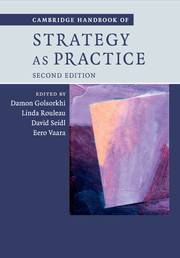Book contents
- Frontmatter
- Contents
- List of figures
- List of tables
- List of boxes
- List of contributors
- Preface to the Second Edition
- Introduction: what is strategy as practice?
- Part I Ontological and Epistemological Questions
- Part II Theoretical Resources: Social Theory
- Part III Theoretical Resources: Organization and Management Theories
- Part IV Methodological Resources
- Part V Substantive Topic Areas
- 31 Strategic planning as practice
- 32 Meetings and workshops as strategy practices
- 33 The role of materiality in the practice of strategy
- 34 Strategy-as-practice research on middle managers’ strategy work
- 35 Participation in strategy work
- 36 The role of emotions in strategizing
- Index
- References
33 - The role of materiality in the practice of strategy
from Part V - Substantive Topic Areas
Published online by Cambridge University Press: 05 October 2015
- Frontmatter
- Contents
- List of figures
- List of tables
- List of boxes
- List of contributors
- Preface to the Second Edition
- Introduction: what is strategy as practice?
- Part I Ontological and Epistemological Questions
- Part II Theoretical Resources: Social Theory
- Part III Theoretical Resources: Organization and Management Theories
- Part IV Methodological Resources
- Part V Substantive Topic Areas
- 31 Strategic planning as practice
- 32 Meetings and workshops as strategy practices
- 33 The role of materiality in the practice of strategy
- 34 Strategy-as-practice research on middle managers’ strategy work
- 35 Participation in strategy work
- 36 The role of emotions in strategizing
- Index
- References
Summary
Introduction
While spatial and material aspects are fundamental to accomplishing any organizational activity and process, these have largely been neglected or treated as mere background in theoretical accounts that explain phenomena such as strategic change. This dearth of research exploring the role of materials has inspired ‘material turns’ in the fields of social studies of finance (for example, MacKenzie 2006; Pinch and Swedberg 2008), organizational routines (for example, D'Adderio 2011; Pentland et al. 2012) and technology studies (for example, Orlikowski 2007; Orlikowski and Scott 2008). Although multiple approaches exist that could shed light on the consequentiality of materiality for strategizing, at present these are not explicitly discussed in the literature.
To establish a research agenda for strategy as practice scholars, this chapter provides an overview of different philosophical approaches and empirical traditions to materiality, explaining the assumptions inherent in each approach and how these assumptions alter the way we understand and study strategizing. When possible, we illustrate the approaches with examples from strategy as practice. In so doing, we develop a typology of materiality that researchers might draw upon to guide their own work. Critically, while this typology is conceptually helpful to better understand the different ways in which one may view and work with materiality, we do not see the approaches as absolutely distinct. Rather, we see them as operating on a sliding scale; some approaches may be blended relatively effortlessly, while others would be impossible to combine given their opposing assumptions. In introducing these approaches, we aim to critically engage with the notion of materiality, encouraging the reader to see materiality as something that goes beyond mere physicality.
In line with these aims, our chapter is structured as follows. We briefly review the philosophical foundations of materiality to demonstrate the rich and diverse origins of the construct. We then introduce four empirical traditions to materiality: the communications approach, the technological approach, the sensemaking approach and the positivist approach. Reflecting on these approaches and their utility to SAP research, we draw up an agenda for future research. Herein we suggest the following as particularly fruitful avenues for research: time and space, and emotion and identity; connecting important levels of analysis, such as institutions and practice; drawing on innovative methods; and, most critically, using materiality to prompt new research questions that will significantly alter our understanding of organizations.
Philosophical approaches to materiality
- Type
- Chapter
- Information
- Cambridge Handbook of Strategy as Practice , pp. 582 - 597Publisher: Cambridge University PressPrint publication year: 2015
References
- 11
- Cited by



